

Go In Depth
Learn more about great organizations OrthoArizona and Circle the City



Learn more about great organizations OrthoArizona and Circle the City
Adrienne Forstner-Barthell, MD, discusses her career as a colon & rectal surgeon in West Phoenix
21 years
National Asset Protec tion
Legal prac tice in 2024
IK E DE VJI
Founde r and Managing At torney
PRO AS SE T PROTECTION
Of Counsel, Davis Miles McGuire Gardner
Of Counsel, Lodmell & Lodmell

202 4 marks 21 years of legal prac tice devoted exclusively to asse t protec tion , wealth preser vation and risk management planning Of ten at the referral of A rizona’s bes t law yers and advisors , we help protec t billions of dollars in personal asse ts for a national client base of thousands of successful clients including:
• Real Es tate Inves tors
• Business Owners and Entrepreneurs
• Physicians
We have a wide range of cut ting edge strategies available that include both well proven conventional domestic planning , of fshore strategies and plans that combine the best of both.
• C - level E xecs
• Family Business O wners
• And Some of Arizona’s Most Successful Law ye rs!



Editor-In-Chief
Desire’e Hardge, MBA
Managing Editor Edward Araujo
Creative Design
Randi Karabin, KarabinCreative.com
Cover & Featured Articles
Photography Jeff Noble, jeffnoblepictures.com
Advertising ads@arizonaphysician.com
Maricopa County Medical Society Board Members
President Jane Lyons, MD
Treasurer Vishal Verma, MD, MBA
Secretary Karyne Vinales, MD
Past President
Zaid Fadul, MD, FS, FAAFP
Directors
Kishlay Anand, MD, MS
Jay Arora, MD, MBA
Rahul S. Rishi, DO, FAAAAI, FACAAI
Ann Cheri Foxx-Leach, MD, D.ABA
Resident & Fellow Director Issa Ismail, DO
Medical Student Director
Samantha Matta, OMS-III

& Rectal
Adrienne Forstner-Barthell,
OrthoArizona’s Board President, Caleb Behrend, MD, discusses the orthopedic practice’s growth and continued success.
Kim Despres, CEO and Jack Palmer, MD, Associate Medical Director of Circle the City’s Mobile Units share how they are providing healthcare to unhoused populations in Phoenix.
Digital & Social Media
arizonaphysician.com
ArizonaPhysician
@AZPhysician

@AZ_Physician
about physician practices in which all their physicians are members of the Maricopa County Medical Society.

am Jane Lyons, MD, Board President of the Maricopa County Medical Society (MCMS), publisher and creator of Arizona Physician magazine.
I want to welcome you in 2024 to our 69th year in publication. I am proud both of leading MCMS and continuing to share with you our magazine that continues to focus on physicians like you.
This year as Arizona Physician shifts to reaching even more physicians outside of Maricopa County, I would like to share with you the importance of organized medicine. To me, organized medicine are collective organizations like MCMS that are dedicated to promoting the best interests of physicians like you and me and uniting all physicians regardless of specialty. Through connective tools like Arizona Physician, we support you, connect you, and support your practice to ensure you are successful as you move forward in your career.
I am a pediatrician and organized medicine has been very important in my medical career. I first became involved in my county medical society during my first year of medical school. I am now an attending physician, almost 10 years past residency. I’m also a busy mother of two young daughters, trying to balance this while still navigating the rewarding yet challenging world of being a physician.
So that just leaves me asking, what can MCMS and Arizona Physician do for you? Are you and/or your practice ready to be featured in our magazine? Can we help your practice obtain discounts? Do you have a topic for an article or a lecture your peers would be interested in? Do you have an idea for a fun activity for our physicians? Is your practice willing to have all its members join MCMS? We can help, just let us know how.
Jane Lyons, MD MCMS Board President
Dr. Jane Lyons is a Pediatrician, who provides care for patients in both the inpatient and outpatient setting. She works locally in Phoenix as well as providing rural locum hospital based care. Dr. Lyons completed her medical training in San Diego, CA, has two young children, and enjoys the outdoors, cooking, and spending time with family and friends.
Advocacy
Pushing policies that matter


Patient Referrals
Online directory and referral line

Professional Referrals
Legal, financial, staffing, real estate, etc.
Scan to learn more about the benefits of being an MCMS member


CME In person and virtual

Physician Stories
Print and digital magazine, podcast
Networking
Happy hours and fun events
Focused on Physicians Like You! Become a Member Today.
“EDUCATION IS THE MOST POWERFUL WEAPON WHICH YOU CAN USE TO CHANGE THE WORLD.”
—Nelson Mandela
2 024 has already been an eventful year full of activity for physicians across Arizona. From business and political tragedies like the Change Healthcare cyber-attack that affected reimbursement for thousands of physicians and patient care to strenuous government intervention affecting physician-patient relationships the year hasn’t started smoothly for physicians across our great state. Yet, MCMS and its publication, Arizona Physician will continuously bring you important bite size information that will keep you informed on what’s happening in medicine and healthcare across the county and state.
Arizona Physician is going to shed light into some of the more positive aspects of medicine in 2024. This year we will continue highlighting individual physicians, medical practices, and now communitybased healthcare organizations creating impact across their communities through the work physicians provide. New departments within the magazine like Community Health, Private Practice, and Tech Trends will join Legal Corner to ensure that physicians remain informed on public health, business trends, new technologies, and important legal information.
In this issue our feature articles will highlight Adrienne Forstner-Barthall, MD, who is one of
Arizona’s top Colon & Rectal surgeons, the impact of Circle the City across Phoenix, and the astonishing growth by one of the premier orthopedic practices in the valley, OrthoArizona.
We will also be highlighting great topics like the importance of community health workers, legal issues physicians may face using telemedicine, how to improve cyber readiness at a medical practice, and what the power of AI is.
Starting in this issue and beyond, we will begin highlighting MCMS member practices through a series of directory ads. Physicians can learn basic details on the practice and what they specialize in making it easier to share with your patients.
As 2024 moves forward, we thank physicians like you for your invaluable work across Arizona communities and to our allies in medicine.
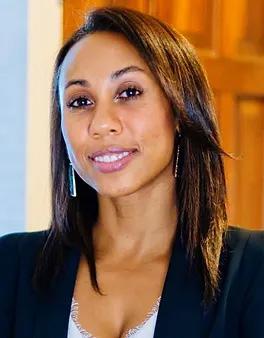
Not an MCMS member? Visit mcmsonline.com/join or call us at (602) 252-2015.
We hope you continue to enjoy the magazine!
 Desire’e Hardge, MBA
Desire’e Hardge, MBA
Arizona Physician Editor-in-Chief MCMS CEO & Executive Director
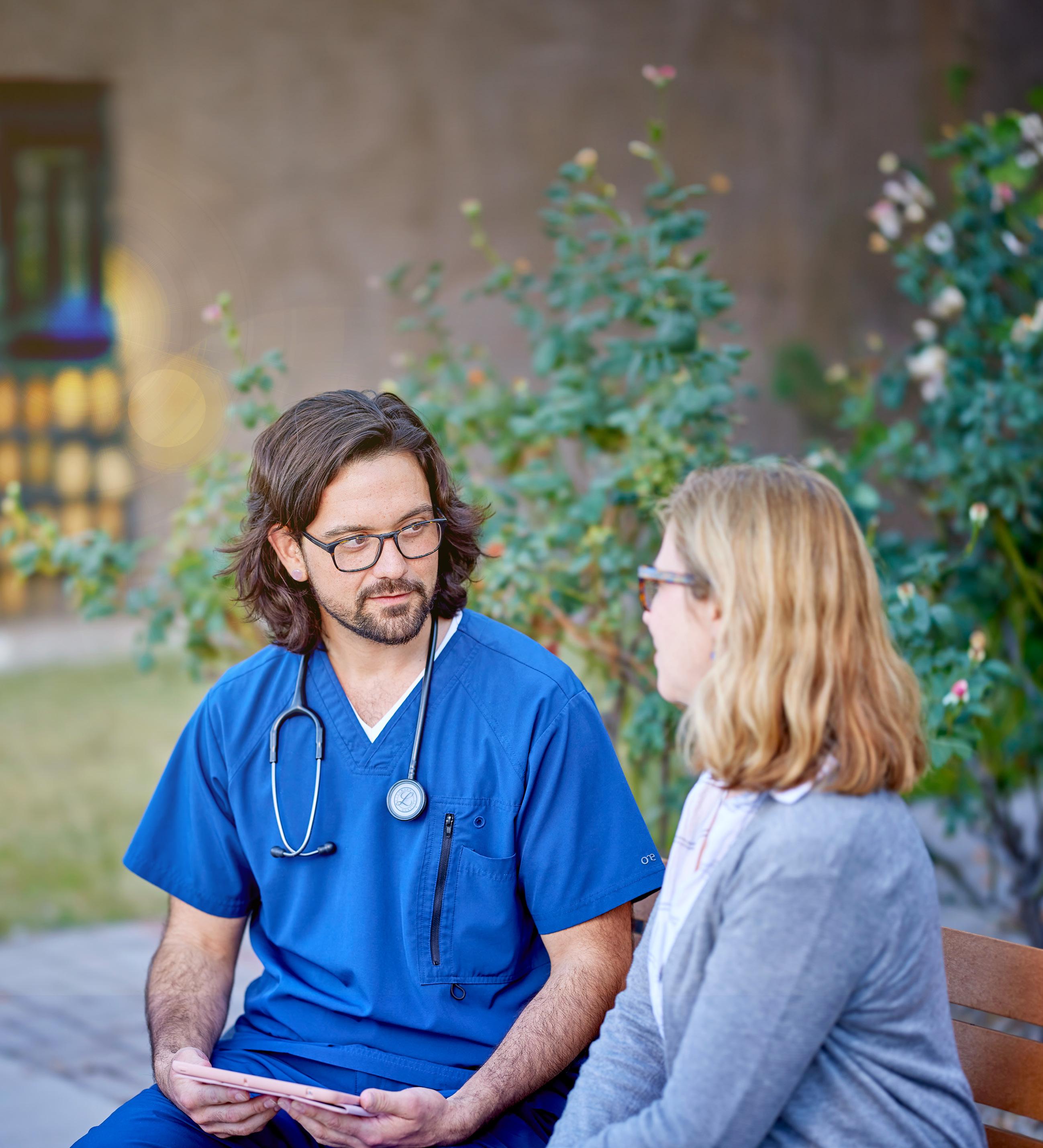

As the days grow longer and our environment awakens from its winter slumber, spring offers the perfect opportunity to refresh your routine and embrace a healthier, more active lifestyle. With warmer temperatures and blooming landscapes, it’s almost hard not to want to take a step outside and soak up the sunshine. There is an abundance of new activities to choose from to take advantage of the changing of seasons, from outdoor adventures to mindful practices, here are some suggestions for spring activities that you might want to consider taking up this season.
1. OUTDOOR EXERCISE | Springtime is the ideal season to take your workouts outdoors and enjoy the beauty of nature while getting fit. Whether it’s going for a run in the park, biking along some scenic trails, or practicing yoga in a peaceful garden, outdoor exercise offers numerous benefits for both physical and mental health. Breathing in the fresh air, feeling the warmth of the sun on your skin, and immersing yourself in natural surroundings can truly be energizing and boost your mood.
2. GARDENING AND NATURE | Spring is synonymous with growth and renewal, which makes it the perfect time to indulge your green thumb and connect with the earth through gardening. Whether you have a backyard garden or simply a few pots on a balcony, tending to plants can be a therapeutic and rewarding activity. Planting flowers, herbs, or vegetables not only adds beauty to your surroundings but also provides opportunities for physical activity and stress relief, as well as some savings when it’s time to go to the grocery store. Additionally, spring offers ample opportunities for exploration and outdoor adventures. Take a leisurely hike through a nearby forest, explore local parks and nature reserves, or just wonder around and see what new spots you might find along the way. Connecting with nature has been shown to reduce stress, improve mood, and enhance overall well-being, making it an essential component of a healthy lifestyle.
3. OUTDOOR SPORTS | Many outdoor sports and recreational activities are now coming back into season, so, whether you enjoy playing tennis, golfing, or participating in team sports like soccer or baseball, spring offers the perfect weather for getting active and having fun outdoors with friends. Engaging in sports and recreational activities can not only be a great cardiovascular exercise, but it also promotes social interaction, teamwork, and camaraderie.
4. MINDFULNESS AND MENTAL HEALTH
PRACTICES | In addition to physical activity, spring is an ideal time to prioritize your mental health and well-being. Incorporating mindfulness practices such as meditation, deep breathing, or just a leisurely walk into your daily routine can help reduce stress, improve concentration, and cultivate a sense of peace and balance. Take time to slow down, savor the present moment, and appreciate the beauty of your surroundings.
5. HEALTHY EATING AND COOKING | Spring has always been a season of abundance, with an array of fresh fruits, vegetables, and herbs coming into season. Take advantage of spring produce by incorporating more fruits and vegetables into your diet and experimenting with new recipes featuring seasonal ingredients. Whether you’re shopping at a local farmers’ market or growing your own herbs and vegetables, eating a nutritious diet rich in fresh, whole foods is essential for maintaining health and vitality.

Arizona is considered a top allergy destination because of its year-round growing season, dry climate, and frequent breezes that allow pollen to travel so easily. There is also a lack of rain, which keeps allergens in the air.
Here are few ways you can reduce your allergy symptoms this spring:
Stay indoors on windy or dry days. Try to avoid allergens by not pulling weeds in the yard or most gardening chores.
Try avoiding activities during midday or in the afternoon when pollen counts are typically at their highest.

Showering and washing your hair after being outside can help. Wash and dry your clothes inside.
Use over-the-counter nasal steroids, antihistamines, decongestants, eye drops, and/ or saline nasal sprays as remedies for allergy symptoms you are experiencing.
Learn more about your allergies. Go and get a blood or skin test so you can identify what you may be allergic to.
Sources: Mayo Clinic & Arizona Allergy Associates







OrthoArizona is a group of multispecialty orthopedic clinics across the Phoenix metro area. Arizona Physician sat down with OrthoArizona’s Board President, Caleb Behrend, MD, who is also a practicing orthopedic spine surgeon. We discussed OrthoArizona’s continued success as one of Arizona’s premier orthopedic groups.
ARIZONA PHYSICIAN: Share with us a brief history of OrthoArizona.
DR. BEHREND: In January 1994, a group of 21 orthopedic surgeons in Phoenix formed the Orthopedic Surgeons Network of Arizona (OSNA), now known as OrthoArizona. Their main objective was to find the best and most accountable orthopedic surgeons who were willing to participate in a rigorous peer review-based quality assurance process. The nature of the group led them to

“Meeting the needs of our patients and creating a satisfying work environment for employees requires a constant focus on operational efficiency, quality, and cost efficiency.”
—Caleb Behrend, MD
become pioneers in alternative payment models over time. This eventually included capitation with over 1 million lives under care in the 1990s. Participation in alternative payment models expanded to include direct-to-employer, commercial and government bundled care models. As an organization we participated in HHS BPCI program and BPCI advanced for more than 12 years. Today that culture remains the mainstay of our practice, led by our vice president of Medical Affairs, Dr. James Davidson and our quality committee, we continue to focus on excellence and value for our patients.
AZP: Dr. Behrend, what is your history with OrthoArizona?
DR. BEHREND: I joined the group from an academic practice at Virginia Tech, where I served as an assistant professor in the School of Medicine. It was a large, wellrun group, and I was not actively looking for a new job. My friends who had shared residency with me invited me to visit and golf. Of course, in the cooler seasons. More than the beautiful climate at that
time of year, I was impressed with the culture and energy of OrthoArizona and, over time, made the decision to make the big move. Aside from marrying my high school sweetheart, Keren Isabel De La Cruz, it has been the best decision I ever made.
AZP: What makes OrthoArizona stand out from other orthopedic groups across Arizona?
DR. BEHREND: We are blessed to have a strong medical and surgical community, particularly in Maricopa County. That said, the reason for the group’s genesis does stand out. Most larger groups are formed for business reasons to meet needs related to market demand, contracting, or cost efficiency. For our group, it was shared values and a philosophical approach to care. This is very special, and I am personally proud to be a part of it.
AZP: Share with us what has changed in orthopedics in the last 10 years.
DR. BEHREND: In orthopedics, in the last two decades, there has been a revolution in care, leading to dramatic cost savings and improved outcomes for patients. A decade ago, outpatient joint replacement surgery or spine surgery would rarely have been performed in an ambulatory setting, and this has become fairly routine today. This not only improves the patient experience but also has staggering cost benefits for the US

healthcare system. This is made possible by continued improvements in surgical technique/technology, anesthesia, and peri-operative approaches to the management of pain. The way for this revolution was paved by sports medicine with improved arthroscopic surgical techniques and hand surgery. Subsequently, total joint replacement and spine surgery followed suit.
AZP: Are there any trends in orthopedics or technology that OrthoArizona is taking advantage of to better help patients while also helping its bottom-line?
DR. BEHREND: We are committed to improving our patients’ experience. Technology that supports reduced workflow complexity and improves our operational efficiency will also improve the work experience for our fantastic team members. Examples include improved online self-scheduling, utilization of AI in revenue cycle management, and call center support. In general, patients are happy with the medical and surgical care, and they want improvements in how phones are answered, appointments and referrals are managed, and how long it takes for them to be seen.
The field of orthopedic surgery continuously sees exciting technological developments resulting from advances in the fields of materials science, molecular biology, robotics, and engineering. Keeping up and choosing what to offer our patients requires a commitment to lifelong learning and evidence-based medicine. As an organization with 80 physicians, this starts with recruiting
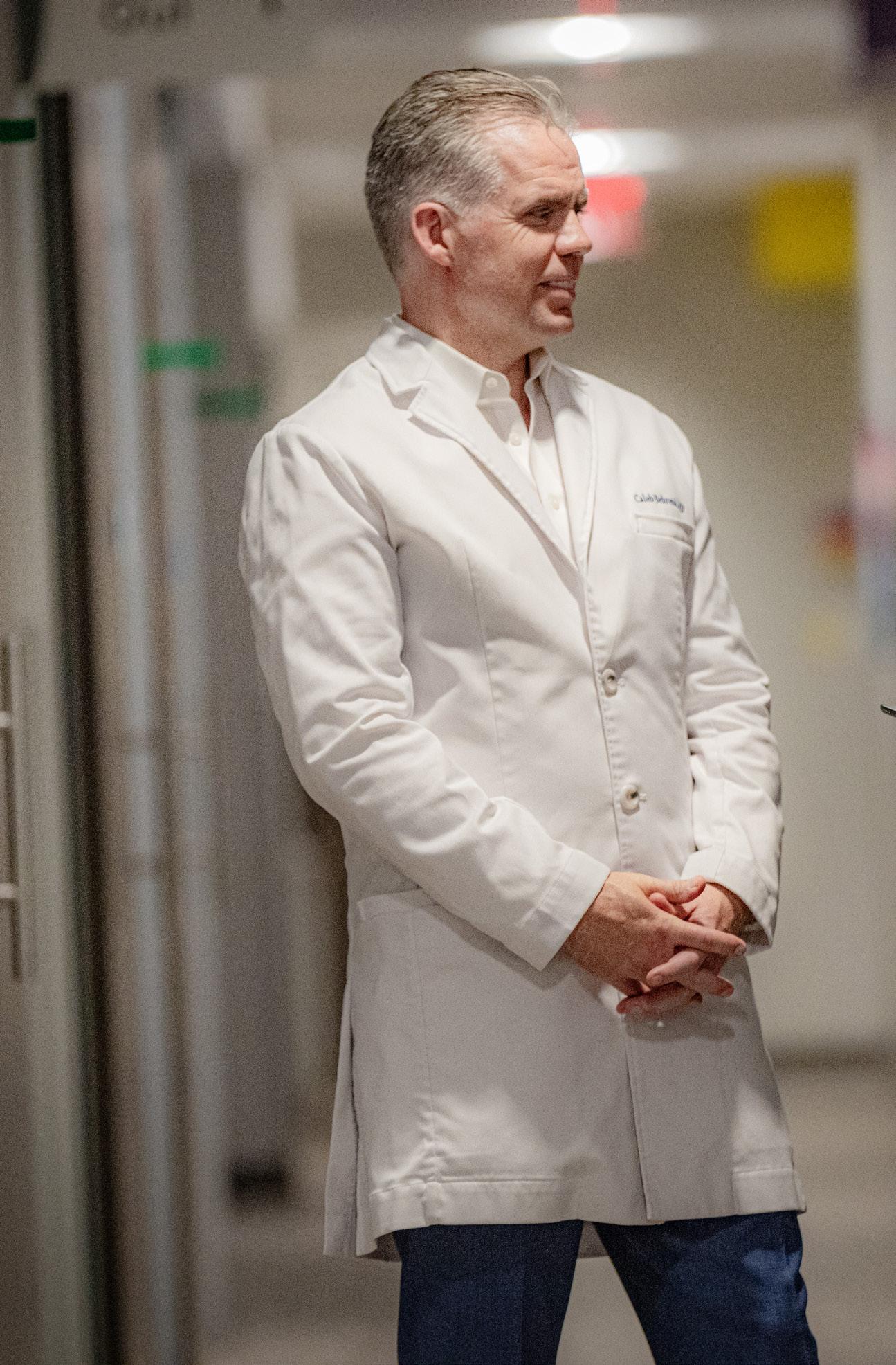
fellowship-trained doctors with expertise in the most current and emerging approaches. We are committed to that and support our long-standing expertise in career development. We are proud to offer a growing number of fellowships and training programs within the company as well.
AZP: OrthoArizona has grown in the last 5 years. You are now at 73 MDs and Dos. How did you get here?
DR. BEHREND: We are 80 physicians. This happened organically over many years as like-minded groups affiliated themselves with OSNA. Some came and went over time due to economics or cultural fit.

AZP: All your current locations are within Maricopa County, are there any thoughts on expanding across the state?
DR. BEHREND: We have offices in Maricopa and Pinal County. Currently, our offices are within reasonable physical proximity to 76% of the state’s population. In addition, we see many patients from surrounding counties who travel from smaller communities. We continue to offer expanded services to patients through telemedicine visits, expanded 24-hour service, and walk-in clinics for urgent orthopedic care. Improving technology and a population that is adapting to different ways of delivering care has allowed us to consistently provide care for patients who see us from other states and as far away as Europe and Canada while maintaining quality.
AZP: Do you see any opportunities that will allow you to get bigger?
DR. BEHREND: There are always opportunities for growth, but it needs to be strategic based on our shared vision and culture, or it will not be
sustainable. We are committed to excellence in all areas of musculoskeletal care and, as a result, continue to expand our non-surgical services through physical therapy and the addition of service lines to provide expanded hours, as well as improved access to care through technology. Regionally, the issue is complex. Seventy-five percent of the state’s residents live within a reasonable distance of our offices. We currently provide care for thousands of patients from other areas of the state each year. We do have a strategic plan to offer our style of medical and surgical care to the entire state. This ideally involves a natural organic alignment of excellent doctors working in other communities rather than an invasion for business reasons. That will require the development of a community of like-minded physicians across the state just as our organization did here in Maricopa and Pinal Counties.
AZP: What do you see are the largest obstacles in running a large group practice today?
DR. BEHREND: Today, we have nearly 1200 amazing team members working at OrthoArizona. We are proud and grateful for everyone on our team. We could not provide excellent care without them. The challenges in sustainably running a larger group medical practice require effective, attentive, and informed leadership. Meeting the needs of our patients and creating a satisfying work environment for employees requires a constant focus on operational efficiency, quality, and cost efficiency. Like most medical and surgical practices, we have worked hard following the pandemic to address challenges from staffing shortages, changes in the work environment, inflation-related costs, as well as threats from increasing liability or cybersecurity attacks. The cost of providing care has increased in the face of declining financial support for physicians by government payers. Action from the state and federal government supporting physicians

“We are committed to excellence in all areas of musculoskeletal care and, as a result, continue to expand access to our services through physical therapy and the addition of service lines, to provide expanded hours, and improved access to care through technology.”
—Caleb Behrend, MD
through increased protection from cybersecurity attacks on healthcare institutions, reasonable tort reform, and a rational plan to support physicians fight against inflationary cost increases would allow doctors to keep the focus on our patients without disruptions, as it should be.
AZP: How many other types of healthcare professionals are working at OrthoArizona?
DR. BEHREND: We have non-operative sports medicine, physical therapy, hand therapy, interventional pain medicine, a talented podiatry group, and physical medicine and rehabilitation practitioners.

AZP: You provide 17 speciality services, which are the most popular with patients?
DR. BEHREND: Physical therapy, medical imaging (MRI/CT/US and X-Ray) are very popular. The mainstays in the surgical divisions remain our sports medicine surgeons, total joints surgeons, hand surgery, and the foot and ankle surgery. Demand for spine surgery and specialized shoulder surgeons continues to push recruiting in these areas to meet the need over time.
AZP: What does the future hold for OrthoArizona?
DR. BEHREND: Currently the future is bright. If the last five years have taught us anything, it is that things can change quickly. We anticipate that changes in technology and policy will provide the biggest threat and opportunity to how we practice and manage our business today. We intend to adapt early with the objective of further improving quality and patient satisfaction.
We face the same challenges any medical group does, large or small, and are working internally to strengthen our management team and operations to avoid the issues that press many groups into corporate or employed models.
Over the next few years, we will continue to build our outpatient surgery programs in collaboration with our regional healthcare systems and will build stronger ties through continued participation in co-management and the growing care networks. I would like to see increasing involvement of our physicians in state and local medical societies. Advocacy for patients and physicians by being present to share their views with our policymakers is essential for the long-term sustainability of our medical community.
We are committed to excellence in all areas of musculoskeletal care and, as a result, continue to expand access to our services through physical therapy and the addition of service lines, to provide expanded hours, and improved access to care through technology. Regionally, further organic growth will occur by the natural alignment of excellent doctors working in other communities over time. ■
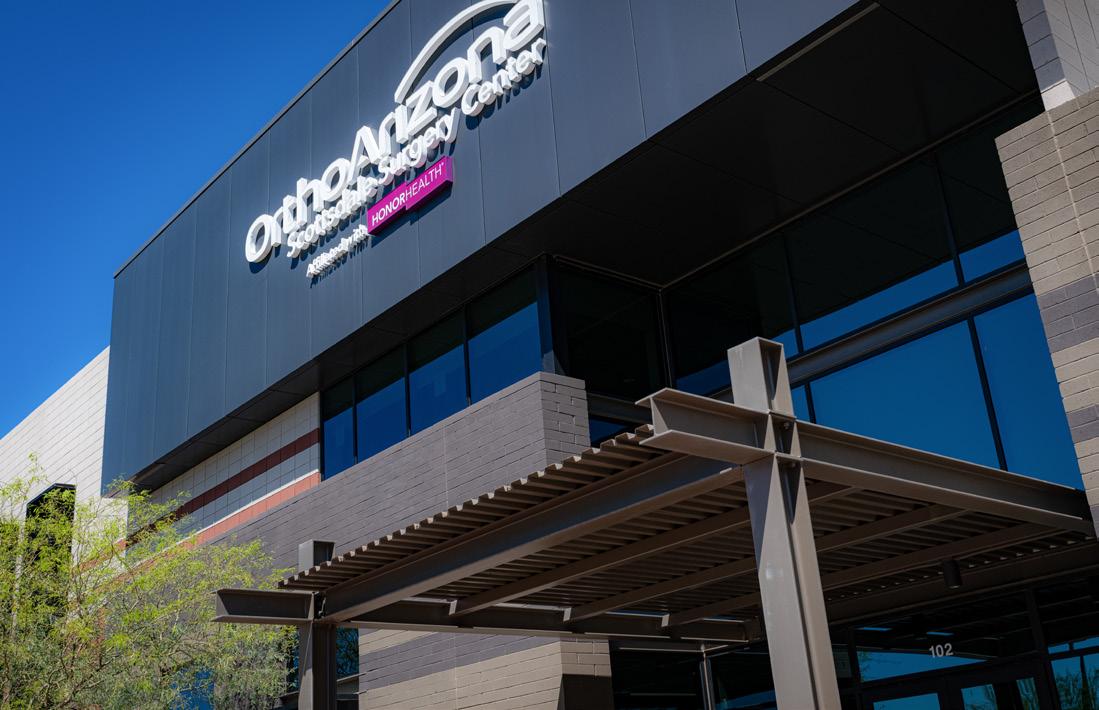
Founded in 1994
79 Physicians
65 Nurse Practitioners and Physician Assistants
123 Physical Therapists, Certified Hand Therapists and Occupational Therapists
Services and Programs
Physician Specialties: Foot & Ankle, General Orthopedics, Hand, Wrist and Elbow, Hip, Interventional Pain, Knee, Fracture & Trauma Care, Physical Medicine & Rehabilitation, Podiatry, Shoulder, Spine, Sports Medicine, Total Joint Replacement & Revision, Worker’s Compensation
Diagnostic Services
MRI & CT Imaging, Ultrasound, X-ray
Rehabilitation Services
Athletic Performance, Physical Therapy, Occupational Therapy/Certified Hand Therapy
Other Services
InstantOrtho™ - OrthoArizona’s Walk-in Clinic for Urgent Orthopedic Care and MedLegal
28 Office locations:
Arcadia, Avondale, Cave Creek, Chandler, Deer Valley, Fountain Hills, Gilbert, Glendale, Litchfield, Mesa, Peoria, Phoenix, San Tan Valley, Scottsdale, Sun Lakes
Connect with OrthoArizona OrthoArizona.org | (602) 648-5444
Seeing sheer gratitude on her patients’ faces post-surgery truly makes Dr. Forstner-Barthell feel like she’s making a difference in their lives. She understands how hard it is for her colon and rectal surgery patients to even discuss the issues that ail them, let alone actual surgery. So, guiding them through those hard times makes a successful surgery that much more rewarding for her.
Adrienne Forstner-Barthell, MD, FACS, FSCRS, is a board-certified colon and rectal surgeon at Arizona Advanced Surgery—Colon and Rectal Center of Arizona. She completed both medical school and residency at Mayo Clinic and completed her fellowship at the Colon and Rectal Clinic of Orlando. She’s been practicing now for over 18 years and specializes in treating colon & rectal problems.
COLON AND RECTAL
Dr. Adrienne Forstner-Barthell’s journey into colon and rectal surgery began in medical school at Mayo Clinic in Rochester, MN and continued here at Mayo Clinic in Scottsdale. She states, “I knew I wanted to do something that incorporated advanced laparoscopic
and potentially robotics at the time I was in training, and we had just done the first robotic procedure in the state of Arizona,” so naturally she was intrigued by the specialty. Yet, she was still swimming in many ideas on what she wanted to specialize in. She would go on to poll her peers and found that only the colorectal surgeons would even go back to medicine if they had to do it all over again, meaning they felt they had the best job satisfaction, in her point of view.
As a colorectal surgeon she performs many procedures including colonoscopies and anything hemorrhoid related plus all cancers including colon, rectal, and anal. Even though Transanal Endoscopic Microsurgery (TEM), which is a procedure that treats rectal tumors and other rectal problems without making any incisions wasn’t new to the U.S., it was being performed in limited areas outside of Arizona. Dr. Forstner-Barthell was one of the first to bring it here. It is now used less often as there are now some very advanced endoscopic resections, which are minimally invasive and are done by both gastrointestinal and colorectal surgeons using a colonoscope. Other less known procedures she performs are interstim or sacral nerve placement and surgical treatment of pilonidal cysts, which include surgical treatment of anal dysplasia.

“My patients ask me all the time, why did you become a colon & rectal surgeon … I tell them I overslept that day in medical school and that was the only thing that was left.”
—Adrienne Forstner-Barthell, MD
Dr. Forstner-Barthell prides herself on building relationships with her patients. She goes above and beyond to ensure their health and wellbeing. For example, she will conduct a colonoscopy on a patient, and see them again for any colon or rectal issues they may experience. Should they develop diverticulitis or cancer she will walk them through the next steps to help support their health success.
Over the years, Dr. Forstner-Barthell has built a level of trust amongst many generations of patients and their family members. These longitudinal relationships help bring joy to the invaluable treatment she provides and gives her purpose.
The Arizona Advanced Surgery is a unique business model with a corporate structure that allows physicians like Dr. Forstner-Barthell to run their own individual practice locations. AAS has two large locations throughout Arizona where multiple physicians work.

Additionally, AAS gives autonomy to each physician partner to decide how many patients they see.
Initially, Dr. Forstner-Barthell partnered with 1 of the 6 founding physician members of Arizona Associated Surgeons, the precursor to AAS. They started with 6 and quickly grew to twenty-one surgeons in western and southern Phoenix metro. Over the years they would merge with another surgical group that had locations throughout the central and eastern Phoenix metro and Scottsdale. From that merger of surgeons, the group would be renamed Arizona Advanced Surgery. AAS was not done yet, during the middle of the pandemic, growth opportunity arose, and they grew to forty-seven surgeons and 8 allied practitioners.
Arizona Advanced Surgery is unique in that it has a corporate structure but allows physicians like Dr. Forstner-Barthell to run their own individual practice locations should they have one. AAS also has two larger locations in which multiple physicians work. AAS allows enough autonomy to each physician partner to decide how many patients they see.
The AAS has many advantages, according to Dr. Forstner-Barthell. 1. AAS is patient centric, which means the patient always comes first, getting back to patients quickly and transparent billing is prioritized through knowledgeable and efficient staff. 2. The ability to negotiate better vendor contracts is another advantage, that helps curtail costs. 3. The company chooses which insurance they take, making things easier for physicians and staff. 4. AAS allows more autonomy for physicians to be successful.
AAS has fourteen locations and forty-five physicians and more opportunities for growth. So, what makes AAS unique? One word, leadership. Dr. ForstnerBarthell shares that leadership doesn’t micromanage its physicians nor the number of patients they have. Along with incredible management, AAS has a great billing system in place that takes the authorization burden off the physicians’ offices, which is a game-changer to her. She cannot stress the importance of having autonomy in decision-making and having great partnerships with each of the forty-five physicians and her colleagues.
Dr. Forstner Barthell shares that the biggest obstacles that AAS and her own practice face are decreasing healthcare reimbursement and increased costs. Costs like increased rents, increased medical supply costs, and employee salaries. As reimbursement is slashed, she fears the next generation of surgeons may really feel that effect. That could turn surgery practices into concierge medicine where it’s all cash pay, or they could end up at
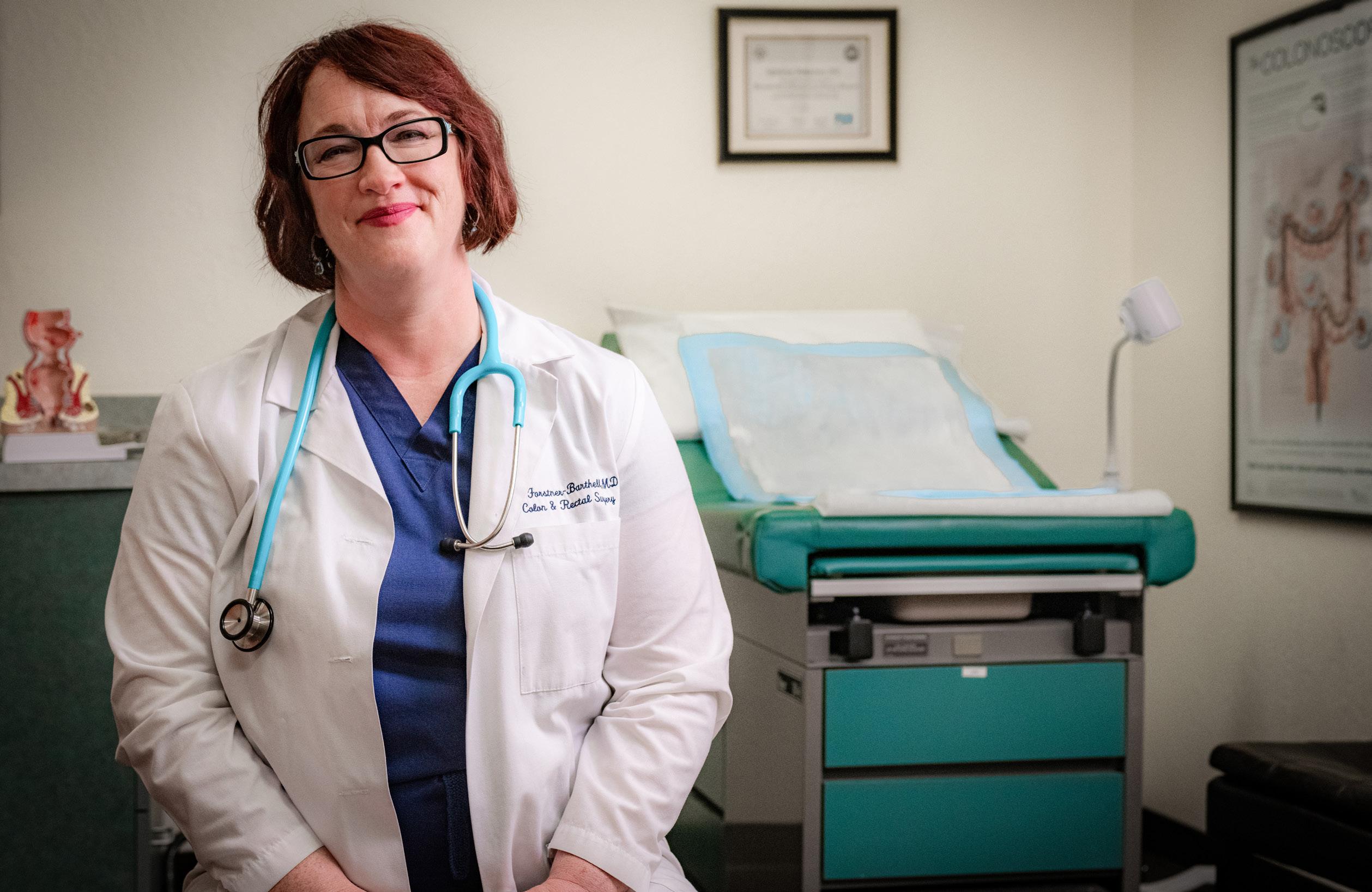
conglomerates where they may be miserable and forced to see patients too quickly to really access their problems.
So, what’s the solution? Dr. Forstner-Barthell shares that her current group is one of the answers as it continues to grow. She also sees physicians may at one point need to own surgery centers, maybe even own hospitals, or at least become investors in them. Currently there are many restrictions and rules that don’t easily allow doctors to do. Yet, she believes using scale to combat the insurance companies’ impact on medicine to allow for better doctor-patient relationships and better gains for surgeons is a good path.
Dr. Forstner-Barthell believes it is important for her to be a positive role model for other women looking to get into medicine and are in medicine. More so, for women getting into surgery…as historically it has been a difficult specialty for women to get in to and stay. She is beyond grateful to the many mentors she’s had along the way and hopes to do the same for others.
Being a colorectal surgeon has allowed Dr. ForstnerBarthell a lot of balance in her life. Her career choice has produced flexibility to allow her to pick the procedures she can do, spend time with her family, and teach in conjunction with running her own practice.
“Colorectal surgery is like the family practice of surgery.”
—Adrienne Forstner-Barthell, MD
She travels regularly and donates time to her charity in Nicaragua, “Por Ellos.”
She is beyond grateful to the many mentors she’s had along the way and hopes to do the same for others. “I think it’s important as a physician to be approachable to young people. I think it’s important to encourage them with what is exciting in medicine. I think it’s important for women physicians to be vocal, to teach and to encourage,” states Dr. Forstner-Barthell. ■
 By Edward Araujo Managing Editor Arizona Physician earaujo@mcmsonline.com
By Edward Araujo Managing Editor Arizona Physician earaujo@mcmsonline.com
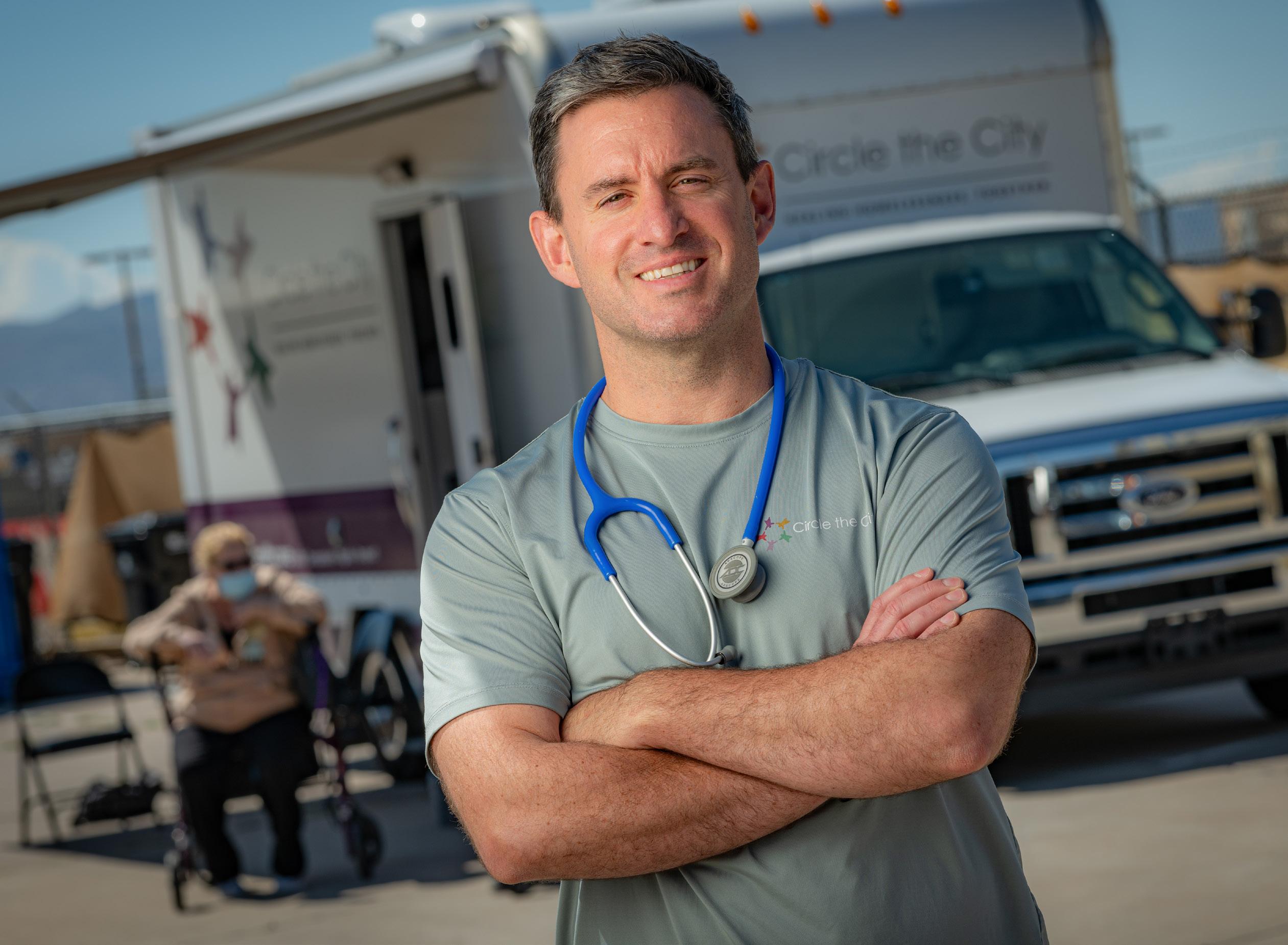
In 2024, Arizona Physician will showcase community-based healthcare organizations in which physicians provide an invaluable service to their impact and success in the communities they serve.
In this issue, Arizona Physician sat down with Circle the City’s Chief Executive Officer, Kim Despres, PhD, and Jack Palmer, MD, Associate Medical Director of Mobile Unit. They shared with us why Circle the City’s programs and services are vital to the community and the impact physicians they employ create within the organization.
ARIZONA PHYSICIAN: Kim, can you please share with us how Circle the City began and what services it provides for patients?
KIM DESPRES: Circle the City was founded by sister Adele O’Sullivan. She is a Catholic nun and a medical doctor. She started in Phoenix as the medical director for healthcare for the homeless, which was down at our Human Services campus. Patients would be dropped off by hospitals at the campus and Sister Adele noticed that they needed further medical care, plus a place to heal. She learned to fundraise; she began literally by collecting money in a shoebox. Many people would meet her and just donate money into the shoebox, as she’s just one of the world’s most wonderful human beings.

She would then take that money and help people with medicines and other resources. The shoebox money eventually became a bank account with the help of her sisters, the Sisters of Saint Joseph of Carondelet. They helped her create an advisory board, which developed into a fiduciary board and that allowed for the first Resource Center to open in 2012. That resource center was a 50 bed, respite center, which is like a mini hospital specifically for people facing homelessness and that are recovering from trauma.
Since 2012, we now have two medical respite centers, each with 50 beds plus two outpatient clinics. We also have five mobile medical units, one of which is a mental health mobile medical unit and two street medicine outreach teams which use backpack medicine.
Our services include outpatient care clinics which provide integrated primary and preventive health, respite care which are centers for men and women to recover from acute illnesses and/or injuries, and mobile units that provide primary and preventative healthcare through mobile teams. Other services include a hospital health navigator program, which connects patients to support services upon being discharged from a hospital, as well as street medicine, which is direct care on the streets to people who are unsheltered.
AZP: What would you say is Circle the City’s focus?
KIM DESPRES: Our focus really reflects our mission statement which focuses on providing innovative healthcare solutions to all individuals facing homelessness. We would love to end homelessness one day. Yet we know that we just need to help one person at a time. We also want to improve access to care as we know it’s so difficult for people to get to us. Many of our patients don’t drive, or even have a bike, or can’t get on a bus. Most of the time they’re walking and moving from place to place. We just want to improve access to care because once we get them in our care and we get them engaged in our services many times that leads to some type of housing.

AZP: Kim, what is it that CTC does better than other providers that are trying to help combat homelessness?
KIM DESPRES: I really think we’re really the experts. At CTC we have 260 employees that are dedicated, committed, and their main goal is to provide healthcare to those that can’t easily access care. We treat the whole person, we provide any support they need, and we address all the social determinants of health. Finally, and most importantly, we make sure they have everything they need to ultimately become housed.
AZP: Share with us how patients typically find Circle the City?
KIM DESPRES: Referrals come to us through a variety of ways. We get them from hospitals, nursing homes, rehab facilities, doctor’s offices, cancer centers, even through the people we work for, those that are unsheltered. Both our outreach team and our street medicine teams encounter people in need across the county. Our outreach teams have a schedule which is posted on our website, so that’s another way people come to us.
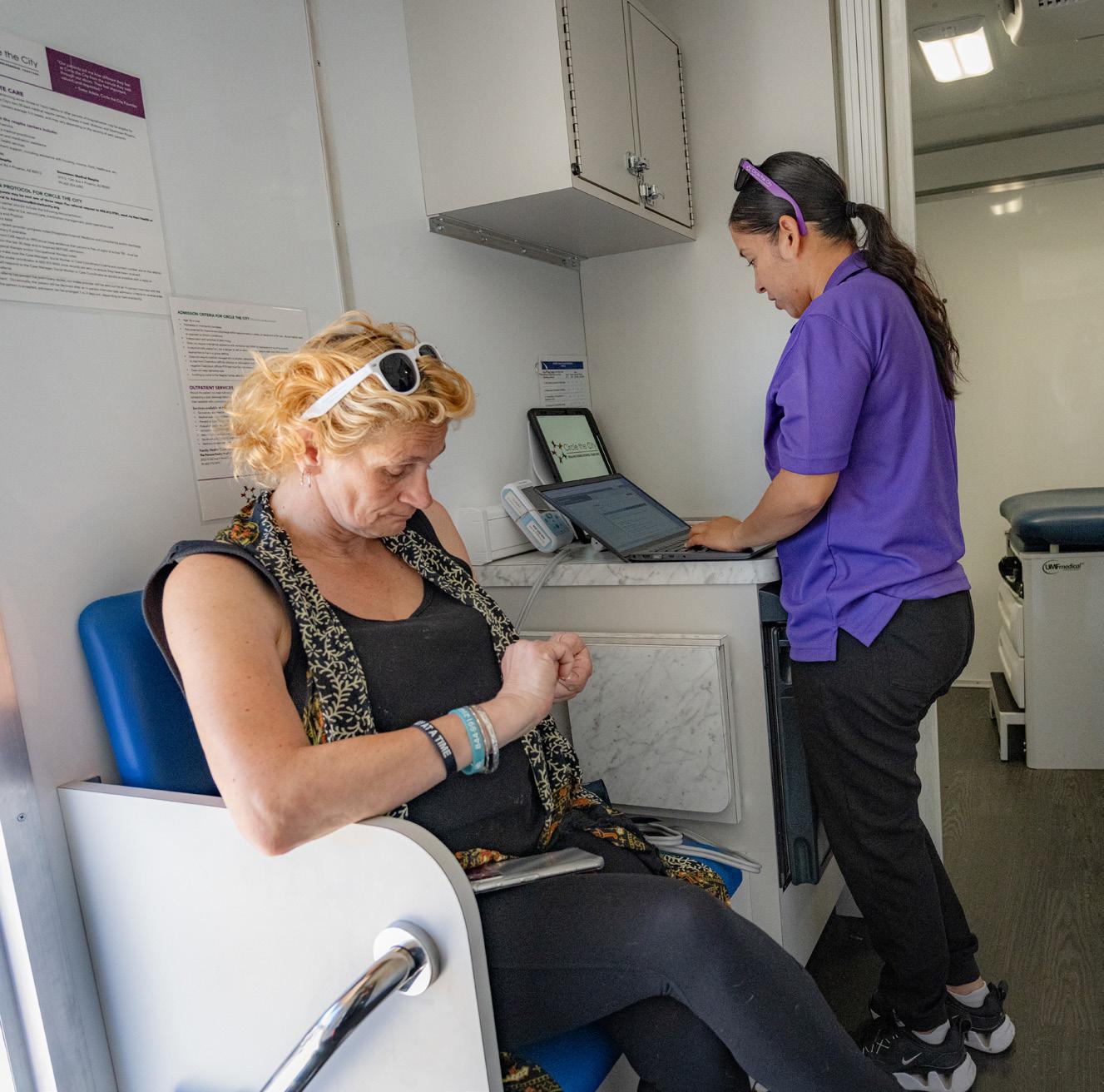
AZP: So, Kim can you share with us how you got to CTC?
KIM DESPRES: I am a nurse by background. I’ve been a nurse for about 40 years and worked all over the valley. My previous job was as an administrator at a large healthcare system for the last 10 years. Yet, I was still searching for something that would fill my soul.
My CTC story begins interestingly when my husband bought us Chinese food one day. It had a fortune cookie and it read, “Do something for somebody less fortunate,” which resonated with me as the next day, our previous CEO, Brandon Clark, called me. We had worked together before and shared with me that he was looking for a Program Director who was a nurse and could run one of our Respite Centers. He asked if I could reach out to any colleagues, I knew that could be interested in the job. I asked him to tell me more. He did. I was interested and even though I hadn’t worked with the unsheltered in the past, I thought the job would be amazing. I met Sister Adele and eight years later, I can honestly say this is the best job I’ve ever had, and it will also be my last.
This job fills my soul because of people like Dr. Palmer and all our providers, nurses, and our staff. You see, when people come to work for us, they know for the most part what they’re getting into, it’s not an easy job, yet it is very fulfilling helping people in our communities. That builds an automatic camaraderie amongst all of us, building a feeling like no other.
AZP: Dr. Palmer, you’re currently the Associate Medical Director of Outreach Medicine at Circle the City. Tell us what some of the medical challenges you see the unhoused face in Arizona?
DR. PALMER: Our patients face innumerable challenges medically. From social determinants of health problems, our patients experience a wide swath of issues, including access to medical care, access to transportation to get to medical care, plus things that you and I may take for granted, like transportation and medical care. In an increasingly technological healthcare system where you and I can get quick access to things like MyChart through our phones, a lot of our patients don’t have phones or even internet access to access appointment information or even lab results. Many of our patients lack transportation or easy access to get their medication at pharmacies. Of the issues surrounding being unhoused, things like safety, exposure to elements like heat & cold, access to quality healthy foods, are all challenges for our patients. These issues are eye opening, and we spend most of our time in our visits with patients overcoming barriers to care as well as trying to remove those barriers to them receiving quality medical care.
AZP: What are some of the diseases or medical conditions that you and your team see that are most suffered by the unhoused population?
DR. PALMER: The hardest medical conditions we see our unhoused patients suffering from are conditions related to the elements, especially here in Arizona. Just last summer you probably saw a lot of stories about heat related illnesses. Those illnesses in our patients are predominately around things like dehydration, heat stroke, and heat exhaustion, which have led to several heat related deaths.
Other things we see are burns and infections related to bad wounds from heat exposure. Those are challenging, so we provide a lot of wound care during the summertime. We also see cold exposure issues in the wintertime as well too. It gets quite cold at night here, so we provide resources from our mobile units, which include warm clothing.
Beyond those issues, our unhoused populations suffer from the same issues the rest of the Arizona population faces including high blood pressure, diabetes, heart disease, and emphysema. Yet, they face a tougher time fighting certain aspects of disease because of a lack of access to quality foods, safety, shelter, and substance addiction. Substance abuse is a very big problem for a lot of our patients. Being exposed to many of our patient’s substance abuse has given me a much bigger appreciation in combatting it. It’s important to tackle it while we are helping our patients with their other problems.
AZP: How did CTC come to offer mobile medical unit healthcare to CTC patients?
DR. PALMER: We started with respite centers and clinics that are traditionally more brick & mortar. Yet, we have been very astute in recognizing that it’s challenging for our patients with social determinants of health issues to come find us. We recognize that we need to get to the patients. That’s one of our values and our motto is to meet patients where they’re at. Through different avenues of funding and fundraising, we began our first mobile outreach clinic and we have now expanded to five mobile outreach vans. We also now have three street medicine teams using smaller vehicles for accessing patients in locations which our larger mobile units can’t reach them.
AZP: It seems like you went from being a traditional mortar and brick non-profit to incorporating mobile units to now even seeing patients wherever they may be. So, it seems you’re obviously seeing the real need for street medicine?
DR. PALMER: Yes, absolutely. Street medicine is a concept that’s been around for a while. It isn’t necessarily a novel idea at this point to what to
what we’re doing. It has a major advantage is we meet patients where they’re at, as many patients struggle with so many things. Most of our patients’ primary concerns are where they are sleeping, what their next meal might be, or how they are going to stay safe. Many times, their medical needs are lower on their priority list. So, at CTC we try to be where they are and help them overcome their medical care barriers like a doctor’s visit. Another advantage of street medicine is that during these visits we perform what we call an integrated care model of care. As a physician, I work with my medical assistant and a psychologist who is a behavioral health consultant as we try to help both medical and mental health needs within our patient population. In some instances, we even bring along health navigators to help our patients with resources.
There aren’t many disadvantages to street medicine, yet a major challenge is that unhoused patients are often forced to move from their current locations to multiple locations, making them difficult to find should they have chronic illnesses. That makes treating them difficult as new zoning laws or even the police can clear them of areas, we treat them at new locations we may not know they’ve been displaced to, and we lose patient contacts we worked hard to build. Waiting to see if they return isn’t necessarily a disadvantage but a challenge. As we must decide whether they will work their way back or if we must go find them.


AZP: Dr. Palmer please share with us why you decided to continue your career at CTC?
DR. PALMER: My medical journey began in emergency medicine. My wife, who is an internal medicine physician and I moved out here to Arizona in 2020, while COVID was peaking, to Circle the City. It has really been an incredible journey for me before and during my time at CTC. I had really felt the pull to join an organization like this one for several years. I really wanted to find a type of practice of medicine that would give me more patient continuity, more patient exposure, and a little bit more fulfillment than I was getting in the emergency room. Don’t get me wrong, I still love emergency medicine. I think as ER doctors we make a big difference in patients’ lives and do great work. But practicing emergency medicine for over 15 years, I felt a pull for different style of practice. During my time at Valleywise Emergency Department, I had contact with health navigators and social workers, which lead me to learn more about CTC and its work with the unhoused community.
So, when I saw a job opportunity present itself, I investigated it a little bit more and then I met with our current and sadly leaving CMO, Dr. Sandoval. I had a lot of trepidation about the work, being that I was an emergency medicine physician coming into a space that is predominantly primary care. But Kim and Dr. Sandoval made me feel very comfortable. They reassured me that even though I would experience a somewhat tough transition, they both thought I could handle it. They let me do some shadowing on a couple of the mobile outreach units, which is where I thought I’d be the best fit. Then I just took the leap of faith… it’s been the right type of practice environment for me. I love our patient population. I’ve always gravitated to working with an underserved population. So, I truly get a lot of fulfillment out of both working in the ER and here. This has been the single best move I’ve ever made in my entire career as it’s been a move I made with intention. I feel that it’s the happiest I’ve ever been in 15 years of practicing medicine.
AZP: Are the current reimbursement models working for organizations like yours?
KIM DESPRES: Well, we’re quite lucky that Arizona is a Medicaid expansion state. So, about 80% of our patients have Medicaid, that’s fabulous. We are currently able to bill Medicaid, Medicare Advantage and even some private insurance which is around another 10%. The final 10% of our patients are uninsured.
Yet, we take anyone that walks in! We don’t turn away anybody. We would love to have more funding for both our uninsured and under-insured populations. We do a significant amount of fundraising and grant applying each year, probably close to $3M a year to pay for services for the final 10% of our patients.
AZP: What changes do think you would like to see happen so that your organization can help more people?
KIM DESPRES: I think better funding or more funding for our uninsured and underinsured patients. CTC can spend $30 — $40K a month on uninsured patient medications and that’s all out of pocket. Should the government help more like during COVID, which has now gone away, we could really help all our health centers with more patients.
AZP: Kim, you’re currently the CEO of Circle City. What are some of the challenges that you see facing the organization?
KIM DESPRES: We have reimbursement challenges working for those that are unsheltered as many are uninsured or underinsured. Also, recruitment can be a challenge. I think medical providers like physicians and nurses are obviously difficult to recruit. We work with a very special population that we care for, and our team must really know what they’re getting into. Plus, I know that nurses across the country on average are aging and many will be retiring soon making it harder to recruit them.
AZP: What does the future hold for Circle the City?
KIM DESPRES: It would be great to say that one day we’ll be all shut down, but I don’t think that’s possible. We have currently received a large grant from the county to open the East Valley Medical Respite Center. We are hoping the Center will house about 100 beds. We’re also in negotiations now for some land and we’ll be building from scratch. We hope construction can begin in early 2025. So, that’s what I think our biggest goal is right now. We have a pretty prominent presence in Central Phoenix but not in the East Valley. We hope this building will help change that. ■
Founded in 2008
15 Physicians Employed
13PA/11NP NPs/PAs Employed
Other clinicians employed?
Nurses and Behavioral Health Consultants
Services and Programs
Downtown Family Health Center, Parsons Family Health Center, Midtown Medical Respite Center, Downtown Medical Respite Center, Mobile Medical Units, Street Medicine
Number of Locations/ Mobile Units and Cities
5 Mobile Medical units (they are stationed in multiple locations across Maricopa County and change sites daily), 2 Street Medicine Teams (Central Phoenix and the East Valley), 1 Mental Health Street Medicine Outreach Team
Connect with Circle the City circlethecity.org | 602-776-0776


Referring them to a Community Health Worker Might Just be the Ticket
Community Health Workers (CHWs) are frontline public health workers who have a trusted relationship with the community and help access to a variety of services and resources for community members. Many work either for pay or as volunteers in both urban and rural environments. CHWs facilitate access to services and improve the quality and cultural competence of service delivery, including the coordination of services to improve medical and behavioral health outcomes.
Building community health workers into the continuum of care has been proven to both improve health outcomes and reduce healthcare costs … especially when it comes to preventing and selfmanaging chronic diseases.
Arizona has been working hard over the last several years to build the infrastructure to use the skills of Community Health Workers at scale within the state’s healthcare network.
This month Arizona Health Care Cost Containment System (AHCCCS) announced that they will begin registering CHWs as AHCCCS providers and be reimbursed for providing Medicaid services starting on April 1, 2024.
Claims for covered services provided by the certified CHW or CHR need to be sent by the registered AHCCCS provider. A CHW can be employed by multiple AHCCCS registered providers.
In order to obtain Medicaid reimbursement, the CHW needs to be certified by ADHS and can only deliver covered services within their scope of practice under specified AHCCCS registered provider types.
The provider types are listed in Question 8 of the CHW/CHR Frequently Asked Questions
Additional billing guidance is available in this AHCCCS Provider Billing Manual. You can also check with your contracted Medicaid health plans for a list of CHWs that are available for clinician referral.
Kudos to the network of industrious and tenacious folks that have been working toward this goal over the last several years!
For a picture of how CHWs can fit into a continuum of care, take a look at this report from the NAU Center for Health Equity Research in collaboration with the UA Prevention Research Center which provides insight into innovative strategies for integrating, sustaining and scaling of the CHW workforce within Medicaid. ■
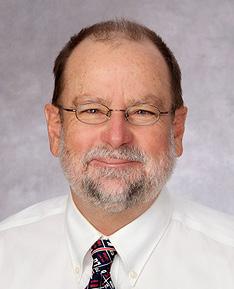 By William Humble, MPH Executive Director Arizona Public Health Association (APHA) willhumble@azpha.org
By William Humble, MPH Executive Director Arizona Public Health Association (APHA) willhumble@azpha.org

Pioneering heart care excellence with next-gen Cath Lab upgrades— optimizing space and technology for peak performance.


The devastating impact of this year’s Change Healthcare cyberattack is another sobering reminder that the U.S. health care industry, from small practices to large hospital systems, must strengthen its defenses against cybercriminals.
Health care entities are reporting large breaches (affecting over 500 individuals) in record numbers to the U.S. Health & Human Services Office of Civil Rights (HHS OCR). In 2023, large breaches impacted over 134 million people, a 141% increase from 2022. Hacking is now the greatest threat to the privacy and security of patients’ protected health information (PHI), accounting for 79% of large breaches reported to OCR in 2023. Between 2019 and 2024, HHS reports that hacking-related large breach reports increased by 256% while those triggered by ransomware attacks jumped by 264%.
Data indicates that hackers are increasingly victimizing physician groups and small or medium size medical practices. HHS points out that attackers seek targets requiring the least time, effort, and money to exploit. Smaller organizations often fit this description, because
their cyber defenses are underdeveloped due to staffing, budget, or time constraints.
Small or medium practices that believe they lack time and resources to implement effective cyber protections should take note: It’s cheaper to beef up cyber defenses than shoulder the staggering costs of a ransomware attack and/or pay penalties for HIPAA non-compliance. Devastating ransomware attacks have driven small practices in Arizona and elsewhere out of business.
OCR recently urged all practices to review their cybersecurity measures. If the task of insulating your practice against cybercriminals seems daunting, start with some basics. HHS recommends implementing these “best practices” to improve HIPAA compliance and mitigate cyberthreat risk:
Address Business Associate Agreements
Review vendor and contractor relationships.
For any vendors that fit the HIPPA Business Associate (BA) definition, ensure you have signed Business Associate Agreements (BAAs).
BAAs must contain specific contractual provisions, such as an agreement by the BA to notify the practice if the BA learns of a security incident or breach of unsecured PHI. HHS offers guidance and a model Business Associate Agreement.
Comply with HIPAA risk analysis and risk management requirements
Complete and document a Security Risk Assessment (SRA) and Risk Management Plan.
OCR has settled numerous enforcement actions with large and small organizations that failed to complete a SRA.
Resources:
• Implement the Health Insurance Portability and Accountability Act (HIPAA) Security Rule: A Cybersecurity Resource Guide
• Review the Health & Human Services online Guidance Portal
• Conduct HHS’ Security Risk Assessment Tool (SRA Tool)
• Conduct a Security Risk Assessment using MICA SRA article
Utilize multi-factor authentication on all workstations and devices
OCR found one of the biggest causes of data breaches is weak authentication measures
Use HHS Implementation Resources
Implement encryption
Encryption makes ePHI unusable, unreadable, or indecipherable by criminals.
If someone steals your laptop, encryption using an HHS-approved method can save you from costly breach reporting obligations. HIPAA Breach Notification requirements apply only to unsecured data.
Resources:
• Review the Health & Human Services online Guidance Portal
• Read MICA article: Breaches Involving Mobile Devices
Monitor information system activity Regular review of information systems’ activity can facilitate early discovery of suspicious activity.
Implement procedures for periodic review of system reports such as audit logs, access reports, and security incident tracking reports.
A medical group that lacked such procedures recently paid $480,000 to settle an OCR post-breach report investigation. The breach stemmed from a phishing attack where the hacker gained access to a physician’s email account.
Resources:
• Review the Health & Human Services online Guidance Portal
Provide workforce training
HIPAA requires regular training and updates for all workforce members addressing:
• security awareness,
• detecting and reporting malicious software, and
• security incident procedures.
Consider conducting phishing simulations and security incident tabletop exercises.
Retain copies of training materials and attendance records.
Resources:
• Review the HHS Implementing Cybersecurity Workforce Training on the HHS website
• Review the HHS 405(d) Social Engineering Resources site page
• Review HITEQ resources in the HITEQ Center Guide
Incorporate lessons learned from security incidents into your overall security management process Eliminating the risk of cyberattacks is impossible. To decrease the risk and limit the scope and consequences of security incidents, take advantage of lessons learned to improve your cyber readiness. ■
 By Jeanne E. Varner Powell, JD Senior Legal Risk Management Consultant, Risk Management Services Mutual Insurance Company of Arizona JVarnerPowell@mica-insurance.com
By Jeanne E. Varner Powell, JD Senior Legal Risk Management Consultant, Risk Management Services Mutual Insurance Company of Arizona JVarnerPowell@mica-insurance.com

The field of telehealth has been rapidly evolving during and after the COVID-19 public health emergency (the “PHE”). There is currently no streamlined regulatory framework applicable to all of the U.S. states. However, this article will provide a condensed overview of a few key Arizona and federal laws that are relevant to physicians providing telemedicine services.
Each state has the authority to regulate the practice of medicine with patients located within the state. Typically, physicians need to be licensed in the state where the patient is located when receiving telehealth services, even if the patient is only there on a temporary basis. Some states, such as Arizona, have telehealth-specific exemptions that allow out-ofstate physicians to render services via telemedicine in a state where the physician is not located, under
certain circumstances such as: unrestricted licensure in another state; registration with the state’s medical board; and an agreement not to establish a physical office within the state.
Additionally, because of the burdens associated with obtaining licensure in each state, there are various healthcare provider licensure compacts that allow specific providers to practice in states they are not licensed in as long as they hold a license in good standing in their home state and otherwise meet the compact’s criteria. There are currently 37 states (including Arizona), the District of Columbia, and the Territory of Guam participating in the Interstate Medical Licensure Compact.
To minimize the risk of disciplinary action by medical boards in states in which the physician is not licensed, it is a good idea for physicians, at the beginning of each telemedicine visit, to ask the patient to confirm where they are located when receiving telemedicine services, and document the same in the medical record.
Under the Ryan Haight Online Pharmacy Consumer Protection Act of 2008, a prior in-person visit is required before a healthcare provider can prescribe a controlled substance to a patient during a telemedicine encounter. During the PHE, the in-person visit was waived such that providers could prescribe controlled substances via telemedicine without first conducting an in-person examination (the “In-Person Visit Waiver”). In addition, the DEA waived the requirement that providers dispensing controlled substances be registered with the DEA in each state in which the provider dispenses controlled substances (collectively with the In-Person Visit Waiver, the “Telemedicine Controlled Substance Prescribing Flexibilities”).
As the PHE approached expiration, the DEA issued multiple temporary rules, and held stakeholder listening sessions addressing the possible extension of the Telemedicine Controlled Substance Prescribing Flexibilities. On October 10, 2023, the DEA issued a second temporary rule extending the Telemedicine Controlled Substance Prescribing Flexibilities through December 31, 2024. This means that until the end of the year if permitted by state law, a physician may issue a controlled substance prescription during a telemedicine encounter without a prior in-person visit, if the following conditions are met:
The prescription is issued for a legitimate medical purpose by a practitioner acting in the usual course of professional practice;
The prescription is issued pursuant to a two-way, audio-video real-time encounter;
The practitioner is (i) authorized to prescribe the class of controlled substance specified on the prescription, or (ii) exempt from obtaining a registration to dispense controlled substances; and
The prescription is consistent with all other applicable legal requirements.
The DEA has stated that it anticipates issuing new rules on the Telemedicine Controlled Substance Prescribing Flexibilities in the fall of 2024. Additionally, physicians practicing in states outside of Arizona should be aware that other states may have specific additional requirements related to the prescription of drugs via telemedicine.
Most states have some telehealth-specific informed consent requirements in their laws and regulations related to the practice of telemedicine. In Arizona, before providing care via telemedicine, providers must: (1) obtain verbal or written informed consent; and (2) document the consent in the patient’s medical record. If the consent is obtained verbally, the provider must document the consent on the patient’s medical record. In addition to documenting the patient’s informed consent in the patient’s medical record, it is advisable to have patients sign a written informed consent (typically a click-through form signed before the telemedicine visit begins), including an acknowledgment of the privacy and security risks associated with the receipt of telehealth services. The U.S. Office of Civil Rights has published guidance for healthcare providers on educating their patients about such risks. Due to the temporary nature of some of the laws affecting telehealth, and the rate at which such laws and regulations are changing, providers practicing telemedicine or otherwise engaged in the field of telehealth should keep a close eye on developments in this area. ■
 By Miranda A. Preston, JD Shareholder Milligan Lawless, PC miranda@milliganlawless.com
By Miranda A. Preston, JD Shareholder Milligan Lawless, PC miranda@milliganlawless.com
Artificial Intelligence (AI) has emerged as a disruptive force in various industries, and healthcare is on the brink of a huge transformation. The integration of AI technologies into healthcare systems offers opportunities to revolutionize patient care, diagnostic accuracy, and efficiency. However, beyond the excitement surrounding its potential, it’s important to take a look at and acknowledge the possible pitfalls and challenges that come with this evolution.
AI-powered diagnostic tools have the potential to revolutionize the way diseases are detected and diagnosed. Machine learning algorithms can analyze large amounts of patient data, including medical images, genetic information, and electronic health records, in order to identify patterns and anomalies with greater accuracy and efficiency than traditional methods. This could lead to earlier detection of diseases and allow for timely intervention, which can result in greatly improved patient outcomes. AI also enables the development of personalized treatment plans that are tailored to individual patient characteristics, such as genetic predispositions, medical history, and lifestyle factors. By analyzing patient data and predicting treatment responses, AI algorithms can optimize therapeutic interventions, minimize adverse effects,

and improve treatment outcomes. This personalized approach should deliver more effective and targeted healthcare interventions. Not only can AI systems have the ability to create personalized treatment plans, AI-driven solutions can also streamline administrative processes, optimize resource allocation, and enhance operational efficiency within healthcare organizations. From appointment scheduling and billing to inventory management and predictive maintenance, AI can automate routine tasks, reduce administrative burdens, and free up healthcare professionals time so that they can focus more on patient care. This increased efficiency translates into cost savings, improved productivity, and better resource utilization across the healthcare ecosystem.

One of the most significant challenges in the deployment of AI in healthcare is the potential for bias in algorithms. AI systems learn from historical data, which may reflect existing biases and disparities in healthcare delivery. If left unchecked, biased algorithms could perpetuate inequities by providing suboptimal care to certain demographic groups. Addressing bias in AI algorithms requires careful data curation, algorithmic transparency, and ongoing monitoring to ensure fair and equitable healthcare outcomes for all patients.
Another challenge which we must overcome that is largely specific to healthcare is privacy. Healthcare data are highly sensitive and subject to stringent privacy regulations, such as the Health Insurance Portability and Accountability Act (HIPAA) in the United States. The
widespread adoption of AI in healthcare raises concerns about the privacy and security of patient data, especially given the potential for data breaches and unauthorized access. Protecting patient privacy requires robust data encryption, access controls, and compliance with regulatory requirements to safeguard sensitive healthcare information from unauthorized disclosure or misuse.
The rapid pace of technological innovation in AI also poses challenges for regulatory bodies such as the World Health Organization and U.S. Department of Health and Human Services, which are tasked with overseeing the safety and efficacy of AI-driven healthcare solutions. Unlike traditional medical devices, which undergo rigorous testing and regulatory approval processes, AI algorithms may evolve rapidly and dynamically, making it challenging to establish standardized validation frameworks. Regulatory agencies must adapt to the changing landscape of AI in healthcare, ensuring that AI-driven medical devices and algorithms meet rigorous safety standards and ethical guidelines.
While AI holds immense potential to transform healthcare delivery and improve patient outcomes, it’s essential to navigate the potential pitfalls and challenges associated with its integration into healthcare systems. Addressing issues such as bias in algorithms, data privacy and security, and regulatory compliance requires a collaborative effort involving healthcare providers, technology developers, policymakers, and regulatory agencies. By addressing these challenges head-on, healthcare professionals can harness the full potential of AI to revolutionize healthcare delivery and improve the quality of care for patients around the world. ■
 By Jordan Martin Arizona State University Student, Class of 2024
By Jordan Martin Arizona State University Student, Class of 2024
Q: Tell us why you decided on sports medicine coming from family medicine? What connects the two?
A: During my college years, I served as the male captain of the University of Arizona Bollywood dance team. Our fellow dancers would often sustain numerous injuries and I would routinely step in and take care of them, which made me realize my passion for dealing with sports injuries. I was fortunate to meet our collegiate sports medicine doctors in our university athletic training rooms anytime we had to deal with serious injuries, and I would ask our medical team about how they became a Sports Medicine physician. I learned that to become a competent Sports Medicine doctor that I would need to understand the needs of athletes not just from a musculoskeletal standpoint, but from a broad medical perspective. I found that having a Family Medicine background provided me with the best tools and resources to provide comprehensive medical care to all athletes. From dealing with respiratory illnesses to mental health issues, I feel confident that my prior Family Medicine background has allowed me to become a skilled Sports Medicine physician when taking care of patients and athletes.
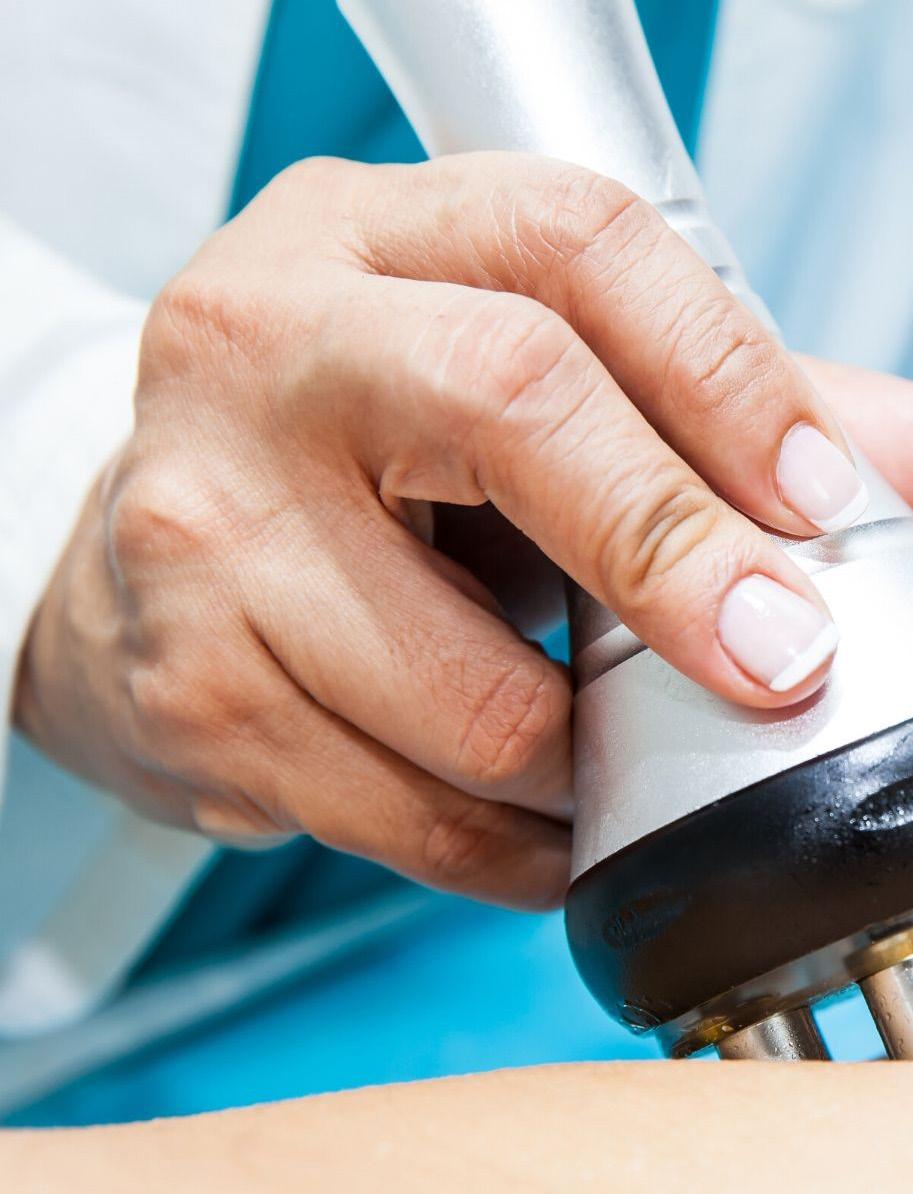
Q: What makes sports medicine unique? Is it only for athletes?
A: Sports Medicine physicians specialize in nonsurgical treatments of various musculoskeletal injuries. We often work collaboratively with orthopedic surgeons as one multidisciplinary team to determine which patients are suitable for non-surgical treatment options versus those that may require surgical intervention. We also provide sports pre-participation physicals and sideline medical coverage at local high schools, colleges, or professional settings depending on the level of experience of each provider. What makes this specialty unique is that whenever we provide sideline medical coverage


for injured athletes, we can follow up with them in our Orthopedic clinic which allows for better continuity of care for the athletes.
Whether you’re an elite athlete, fitness enthusiast, or weekend warrior, we are passionate about helping people get back to what they love doing the most. Sports Medicine specialists take care of all patients with orthopedic injuries, regardless of their age or needs.
Q: Why is ultrasound used as a diagnostic tool for sports injuries?
A: In sports medicine, ultrasound is useful for diagnostic purposes as it facilitates evaluation of various musculoskeletal structures. For example, a doctor may use ultrasound to look at the Rotator cuff tendons and calf muscle to assess for tears during sports injuries. Ultrasound can also be used to look for fluid around or within a structure as an indication of inflammation (muscle), tendonitis (tendons), or bursitis (bursa) throughout the body. A sports medicine physician may also be able to look at a structure as it progresses through the range of motion of that body part to look for any abnormalities. In addition to its diagnostic uses, I frequently use ultrasound in my clinic to perform therapeutic procedures to allow for direct visualization of the target structure being injected. When used in this way, the needle can be visualized as it is directed into the target during the procedure while decreasing the chances of causing pain when avoiding other structures. Ultrasound has the advantages of being relatively inexpensive, very accessible, and highly accurate for the experienced physician.
Q: Share with us the benefits of platelet-rich plasma injections? Are there any negative effects?
A: Platelet-rich Plasma (PRP) injections contain growth factors, proteins, cytokines, and other bioactive molecules that initiate and regulate the basic aspects of wound healing via cell signaling. The goal is to change the inflammatory process of the joint or diseased tendon to promote proper and long-term healing. There has been an increasing number of high-quality clinical research studies suggesting that this can be a safe and potentially efficacious treatment, and it is widely being adopted as a popular non-surgical treatment option in the world of musculoskeletal conditions.
Fortunately, there are few risks to doing PRP injections such as bleeding, pain, and infection which are no different than performing any other type of injection. PRP is not expected to create allergic responses or increased risks of cross reactivity, if the autologous PRP is harvested from the patient’s own body and used only for that person.
Q: Can you share more about the HonorHealth Sports Medicine Program? How can physicians learn more about the program?
A: At HonorHealth Sports Medicine, we are a dedicated group of board-certified Sports Medicine physicians and Orthopedic surgeons who work in a multidisciplinary and collaborative team environment. We have the skills and experience to treat injuries and conditions for all types of patients regardless of their age and skill level. Treatment options can range from musculoskeletal ultrasound-guided procedures, fracture care management, Concussion care, and surgical intervention. We are the official medical providers for the Scottsdale Unified School District (SUSD) athletic department, and our Sports Medicine physicians provide sideline medical coverage for various sports at each respective high school and work closely with their athletic trainers.
We will go the extra mile to ensure patients get back to doing the activities and sports they love as quickly and as safely as possible. ■
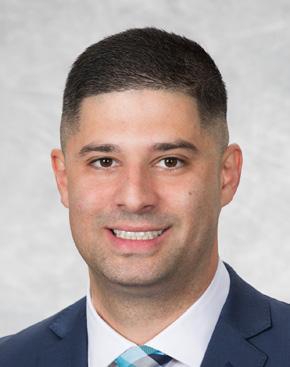
TOP SPECIALTY | SURGERY

OVERVIEW | Arizona Advanced Surgery (AAS) provides patients with the highest quality surgical care and the latest surgical techniques. Surgeons at AAS deliver expert surgical care while minimizing disruption to patients’ lives. They routinely perform minimally invasive procedures that dramatically reduce risks and recovery time.
SERVICES AND CONDITIONS TREATED | Bariatric surgery, colon & rectal surgery, general surgery, laparoscopic surgery procedures, plastic surgery, robotic surgery, surgical oncology, trauma surgery, and vascular surgery.
NUMBER OF PHYSICIANS | 45
LOCATIONS | 14 offices in Chandler, Gilbert, Glendale, Goodyear, Mesa, Peoria, Phoenix, Scottsdale, and Surprise
MAIN OFFICE | 2945 S Dobson Rd, Mesa, AZ 85202 480-969-4138
WEBSITE | arizonaadvancedsurgery.com

OVERVIEW | As the foremost urogynecology practice in Phoenix, Arizona, Valley Urogynecology Associates offers exemplary care to patients with urinary and gynecologic issues. Valley Urogynecology Associates emphasizes a strong quality of life for every patient. The team offers a variety of treatment options, from conservative nonsurgical care, like lifestyle changes and medication, to advanced treatments, including minimally invasive vaginal surgery and robotic surgery.
SERVICES AND CONDITIONS TREATED | Hysterectomies, urinary incontinence, thermiVA, overactive bladders, fecal incontinence, pelvic organ prolapse, sacral nerve stimulation, bladder Botox, Vesicovaginal fistula, vaginal suspension, rectovaginal fistula, robotic surgery, laparoscopic surgery, and urethral bulking.
NUMBER OF PHYSICIANS | 4
LOCATIONS | 1 office in Phoenix
MAIN OFFICE | 1616 E Maryland Ave, Phoenix, AZ 85016 602-788-1521
WEBSITE | valleyurogynecology.com
TOP SPECIALTY | PEDIATRICS

OVERVIEW | Pediatrix physicians and staff focus on the overall well-being of children. They believe each child is a special individual; thus, they consider the specific needs of the child at each visit. Likewise, Pediatrix address parents’ concerns to help families meet the needs of their children. In cases of children with special needs, Pediatrix coordinates referral care from specialists to ensure the process of care moves smoothly for parents. Children not only experience special attention at Pediatrix; they also receive the finest medical care.
SERVICES AND CONDITIONS TREATED | Care of premature infants, care for children with special needs, adolescent care, ADHD management, pediatric nutrition & obesity prevention.
NUMBER OF PHYSICIANS | 8
LOCATIONS | 2 offices in Phoenix (Black Canyon & Happy Valley)
MAIN OFFICE | 15650 N Black Canyon Hwy, STE 100, Phoenix, AZ 85053 | 602-866-0550
WEBSITE | pediatrixmd.com

OVERVIEW | The doctors at Vascular & Interventional Partners are renowned in the Phoenix area for their knowledge and specialized procedural skills. Our expertise comes from decades of combined experience treating some of the most complex medical conditions in Arizona. Our team’s commitment to improving the health and wellness of our patients has helped us become one of the most respected interventional radiology (IR) divisions in the state.
SERVICES AND CONDITIONS TREATED | Oncology, venous disease, neurovascular, men & women’s health, spine care, dialysis access, Gi interventions, arterial disease treatment, join pain treatment.
NUMBER OF PHYSICIANS | 7
LOCATIONS | 2 offices in Scottsdale and Glendale
MAIN OFFICE | 22455 N Miller Rd #B100, Scottsdale, AZ 85255 | 480-613-3445
WEBSITE | vipinternational.com
OVERVIEW | Valley ENT is a multi-practice physician group that specializes in otolaryngology, allergy, audiology, and facial plastics. No matter the ear, nose, and throat problem, the physicians and providers at Valley ENT can take care of the problem with expertise and care.
SERVICES AND CONDITIONS TREATED | Adult ENT services, allergies & asthma, facial/cosmetic surgery, snoring & sleep apnea, dizziness & balance, head & neck cancer, swallowing & speech issues, hearing loss & hearing aids, sinus conditions & nasal surgery, thyroid, parathyroid & salivary issues.
NUMBER OF PHYSICIANS | 39
LOCATIONS | 18 offices in Phoenix, Glendale, Chandler, Mesa, Scottsdale, Flagstaff, Green Valley, Sierra Vista, and Tucson
MAIN OFFICE | 9097 E Desert Cove, STE 250, Scottsdale, AZ 85260 | 480-614-0499
WEBSITE | azvent.com
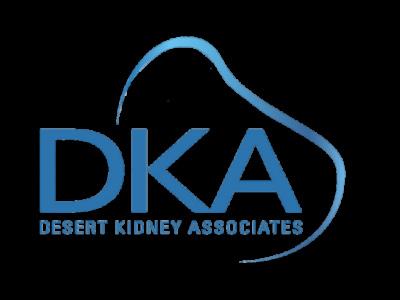
OVERVIEW | DKA physicians are tireless advocates for Arizona patients vulnerable or already suffering from CKD and those experiencing end-stage renal disease (ESRD). Their mission is to meet the varied needs of each patient, provide value and excellence in their care, and work to improve every patient’s quality of life.
SERVICES AND CONDITIONS TREATED | Chronic kidney disease treatment, kidney transplant management, kidney stone management, kidney transplants, dialysis, diabetic neuropathy, hypertension treatment, hematuria.
NUMBER OF PHYSICIANS | 14
LOCATIONS | 16 offices in Phoenix, Avondale, Chandler, Mesa, Casa Grande, Florence, Gilbert, Globe, Lake Havasu, Maricopa, Prescott, San Tan Valley, Show Low, and Sun Lakes.
MAIN OFFICE | 612 W Baseline Rd, Mesa, AZ 85210 480-834-9039
WEBSITE | desertkidney.com

OVERVIEW | DISC is an orthopedic spine center of excellence practice serving spine patients in the greater Phoenix, Arizona area. DISC surgeons treat a wide array of spine conditions such as herniated disc, sciatica, spinal stenosis, and degenerative disc disease. DISC provides compassionate and customized patient care to those suffering in pain.
SERVICES AND CONDITIONS TREATED | Artificial disc replacement, endoscopic spine surgery, selective endoscopic discectomy, endoscopic visualized dorsal rhizotomy, and endoscopic foraminoplasty.
NUMBER OF PHYSICIANS | 5
LOCATIONS | 6 offices in Phoenix, Gilbert, Glendale, and Scottsdale
MAIN OFFICE | 1635 E Myrtle Ave, STE 400, Phoenix, AZ 85020 | 602-944-2900
WEBSITE | sciatica.com
TOP SPECIALTY | OTOLARYNGOLOGY

OVERVIEW | AOC provides multiple levels of comprehensive primary ENT care including the diagnosis and management of all diseases of the ears, nose, throat, and sinuses.
SERVICES AND CONDITIONS TREATED | Management of pediatric airway, cancer, skill base surgery, neuro-otology, advanced head & neck surgery, craniofacial surgery, ENT diseases, pediatric otolaryngology, laryngology, endoscopic sinus surgery, audiology & hearing aids, voice & swallowing disorders, thyroid & parathyroid.
NUMBER OF PHYSICIANS | 8
LOCATIONS | 3 offices in Phoenix, Glendale, and Mesa
MAIN OFFICE | 4530 E Shea Blvd, STE 180, AZ 85028 602-264-4834
WEBSITE | aocphysicians.com
TOP SPECIALTY | OPHTHALMOLOGY

OVERVIEW | Associated Retinal Consultants has an experienced team of Arizona eye specialists that diagnose and treat vision problems. Their focus is on the retina and macula (the back of the eye) and the vitreous humor (gel like tissue) in the eye.
SERVICES AND CONDITIONS TREATED | Retinal diseases, ocular oncology, inherited retinal disease, retina surgery, and clinical trials.
NUMBER OF PHYSICIANS | 10
LOCATIONS | 13 offices in Phoenix, Gilbert, Goodyear, Mesa, Scottsdale, Peoria, Prescott Valley, Prescott, Casa Grande, Cottonwood, Flagstaff, Payson, and Sedona.
MAIN OFFICE | 1750 E Glendale Ave, Phoenix, AZ 85020 602-242-4928
WEBSITE | associatedretinalconsultants.com

OVERVIEW | Radiation Oncologists of Central Arizona, LLP (ROCA) has been offering compassionate, cutting-edge cancer treatment to Valley residents for over 20 years at the premier hospital-based cancer centers in metro Phoenix. ROCA physicians are internationally recognized leaders in advanced radiotherapy technology and have introduced state-of-the-art therapies to the Valley. ROCA physicians have also provided Arizona’s cancer patients access to clinical trials through collaborative research organizations.
SERVICES AND CONDITIONS TREATED | Lung cancer, breast cancer, prostate cancer, brain cancer, trigeminal neuralgia, abdominal cancer, acoustic neuroma, and arteriovenous malformations (AVM).
NUMBER OF PHYSICIANS | 4
LOCATIONS | 1 office in Phoenix
MAIN OFFICE | 4611 E Shea Blvd, STE 120, Phoenix, AZ 85028 602-441-3845
WEBSITE | phoenixcyberknifecenter.com
TOP SPECIALTY | KIDNEY, LIVER, & PANCREAS SURGERY

OVERVIEW | Arizona Transplant Associates has continued to wage war on cancer for decades.
SERVICES AND CONDITIONS TREATED | Whipple procedures, liver resections, liver transplants, kidney transplants, kidneypancreas transplants, pancreas transplants, and other pancreas & bile duct resections.
NUMBER OF PHYSICIANS | 6
LOCATIONS | 1 office in Phoenix
MAIN OFFICE | 2218 N 3rd Street, Phoenix, AZ 85004
602-252-2543
WEBSITE | aztransplant.com
TOP SPECIALTY | OPHTHALMOLOGY

OVERVIEW | At Retinal Consultants of Arizona, they diagnose and find new innovative treatments for retinal conditions. Their goal is to provide patients the best possible outcomes for their unique retinal needs.
SERVICES AND CONDITIONS TREATED | Diabetic macular edema, diabetic retinopathy, flashes, floaters, macular degeneration, macular holes, macular pucker, posterior vitreous separation, retinal artery occlusions, retinal detachment, retinal tears, retinal vein occlusions, and uveitis
NUMBER OF PHYSICIANS | 7
LOCATIONS | 15 offices in Phoenix, Gilbert, Mesa, Peoria, Scottsdale, Bullhead City, Flagstaff, Kingman, Payson, Prescott, Yuma, and Yuma Foothills
MAIN OFFICE | 1101 E Missouri Ave, Phoenix, AZ 85014 602-222-2221
WEBSITE | retinalconsultantsaz.com

OVERVIEW | At Arizona Preferred Surgeons, their surgeons are skilled in complex decision making and diagnosis, as well as treatment and management.
SERVICES AND CONDITIONS TREATED | From anal fistula & fissures, appendectomies, breast surgery, colon cancer surgery, colonoscopies & upper endoscopies, Crohn’s & Ulcerative colitis, diverticulitis, fecal incontinence, gallbladder surgery, gastric resection, hernia surgery, hemorrhoids, and Nissen Fundoplication.
NUMBER OF PHYSICIANS | 3
LOCATIONS | 1 office in Glendale
MAIN OFFICE | 18699 N 67th Ave, Glendale, AZ 85308
602-995-0822
WEBSITE | azpreferredsurgeons.com
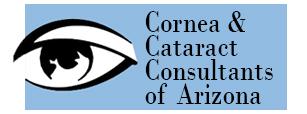
OVERVIEW | Cornea Consultants of Arizona has been serving patients of all ages for a wide variety of ophthalmic conditions of the cornea and anterior segment for the past 35 years. Each of their physicians are board certified and have completed over 13 years of training including medical school, internship, ophthalmology residency, and an additional fellowship year in cornea, external disease, and refractive surgery.
SERVICES AND CONDITIONS TREATED | Cornea transplant, dry eyes/external diseases, investigative trials, laser vision correction, and premium cataract surgery.
NUMBER OF PHYSICIANS | 3
LOCATIONS | 4 offices in Phoenix, Chandler, Peoria, and Prescott Valley
MAIN OFFICE | 3815 E Bell Rd, STE 2500, Phoenix, AZ 85032 602-258-4321
WEBSITE | corneaaz.com
TOP SPECIALTY | DERMATOLOGY

OVERVIEW | Arizona Dermatology is proud to be a leader in the skin care industry and they strive to provide the highestquality medical dermatology, skin cancer treatments, cosmetic procedures, and med spa aesthetic services in Arizona. They use advanced techniques, expertise, and state of the art technology that allow them to provide unparalleled skin care results.
SERVICES AND CONDITIONS TREATED | Medical Dermatology (wart removal, acne treatments, psoriasis treatments, rosacea treatments, vitiligo treatments, melasma treatments), skin cancer (skin cancer screening, Mohs therapy skin cancer treatment), Botox, facial fillers, and Medspa services (intense pulse light therapy (IPL), micro-needling, chemical peels, vascular laser, dermaplaning, and microdermabrasion).
NUMBER OF PHYSICIANS | 6
LOCATIONS | 5 offices in Phoenix, Paradise Valley, Apache Junction, Mesa, and Show Low
MAIN OFFICE | 4835 E Cactus Rd, STE 155, Scottsdale, AZ 85254 | 602-996-3050
WEBSITE | arizonaderm.com
TOP SPECIALTY | PEDIATRICS

OVERVIEW | Pleasant Pediatrics was founded in 2008 by a devoted husband-wife team with a vision of providing compassionate, family-centered care. The Pleasant Pediatrics logo of three joyful children (inspired by the founders’ triplets) represents their inspirations and commitment to nurturing every child’s wellbeing.
SERVICES AND CONDITIONS TREATED | Routine well child exams, sports physicals for school, immunizations, TB skin testing, hemoglobin, urinalysis, rapid strep treatment, flu testing, pregnancy testing, antibiotic injections, circumcision, ear lavage, frenectomy (tongue tie), umbilical granuloma, and nebulizer treatments.
NUMBER OF PHYSICIANS | 16
LOCATIONS | 8 offices in Peoria, Glendale, Ahwatukee, and Phoenix
MAIN OFFICE | 9059 W Lake Pleasant Pkwy, STE E540, Peoria, AZ 85382 | 623-322-3380
WEBSITE | pleasantpediatrics.com
Arizona Physician Magazine
326 E Coronado Rd, Suite 101
Phoenix, AZ 85004
(602) 417-2303
information@arizonaphysician.com
“I signed up with MICA because of their strong support for the Maricopa County Medical Society. I appreciate the longstanding, positive reputation MICA has maintained in the medical community, as an organization founded by physicians and for physicians.” – Dr. Zaid Fadul, MCMS Past President
• Financial strength with one of the strongest balance sheets among carriers
• $730 million in dividends returned to policyholders since inception
• Over $100 million in dividends returned in the last 5 years
• Cyber Liability and Regulatory Defense Coverage at no additional charge
• Flexible coverage options and discounts available for qualified members
